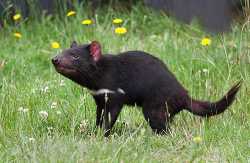21 Jan Tasmanian Devils Have Given Rise To Two Distinct Transmissible Cancers

Dr. Murchison
MedicalResearch.com Interview with:
Dr. Elizabeth Murchison
Menzies Institute for Medical Research
University of Tasmania
Save the Tasmanian Devil Program
Tasmanian Department of Primary Industries, Parks, Water and the Environment
Hobart Australia
Department of Veterinary Medicine
University of Cambridge, Cambridge UK
Medical Research: What is the background for this study?
Dr. Murchison: Transmissible cancers are cancers that can be transmitted between individuals by the transfer of living cancer cells. Transmissible cancers emerge only very rarely in nature, and until now only three examples were known. One of the three known naturally occurring transmissible cancers affects Tasmanian devils, the world’s largest carnivorous marsupial. This disease, which causes disfiguring facial tumours, was first observed in the late 1990s, and since then the disease has spread widely through the Tasmanian devil population. This transmissible cancer first emerged as a cancer in a single individual Tasmanian devil that probably lived about 30 years ago; this devil’s cancer cells have continued to survive by transmitting between hosts by biting.
Medical Research: What are the main findings?
Dr. Murchison: In late 2014, routine monitoring of the Tasmanian devil population led to the discovery of a male devil with facial tumours that resembled the known Tasmanian devil transmissible facial cancer. However, genetic analysis of this tumour indicated that the tumour in this devil was derived from a second transmissible cancer that was genetically unrelated to the first transmissible cancer in this species. Indeed, the genetic profile of this second cancer indicated that it had originally emerged from a male animal. This second cancer has subsequently been found in nine additional devils in the same part of Tasmania.

Tasmanian Devil
Medical Research: What should clinicians and patients take away from your report?
Dr. Murchison: Our study has shown that Tasmanian devils have given rise to two distinct transmissible cancers, both of which cause facial tumours. This is a very surprising finding, and suggests that transmissible cancers may emerge in nature more frequently than previously considered.
Medical Research: What recommendations do you have for future research as a result of this study?
Dr. Murchison: We now want to know what causes transmissible cancers to arise in Tasmanian devils. Additionally, scientists and clinicians should be aware of the possibility that transmissible cancers could emerge in other species, including humans.
Citation:
[wysija_form id=”5″]
Dr. Elizabeth Murchison (2016). Tasmanian Devils Have Given Rise To Two Distinct Transmissible Cancers
Last Updated on January 21, 2016 by Marie Benz MD FAAD
